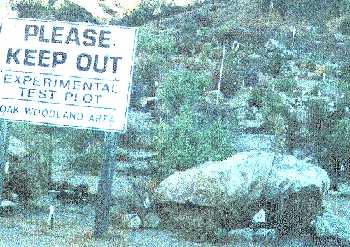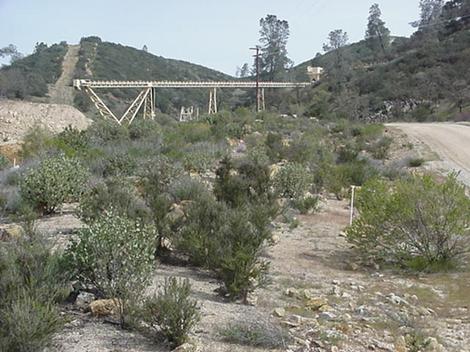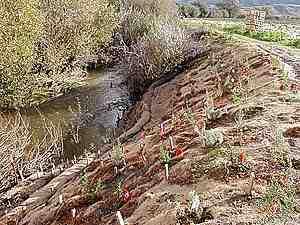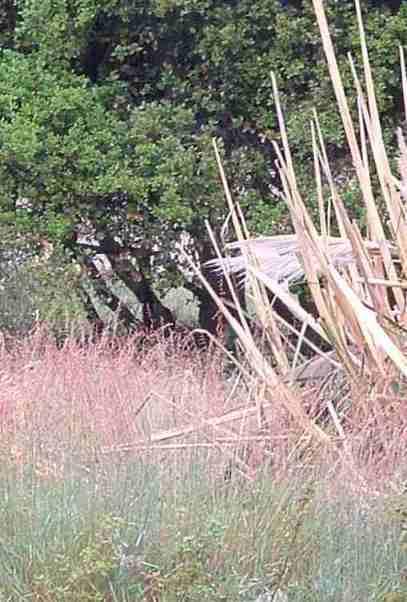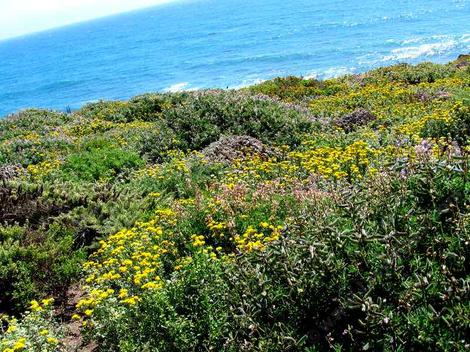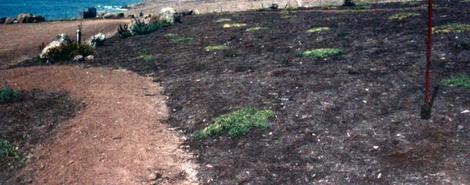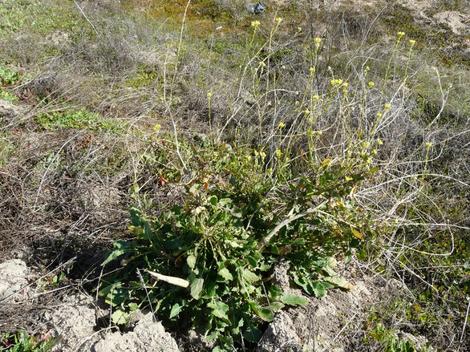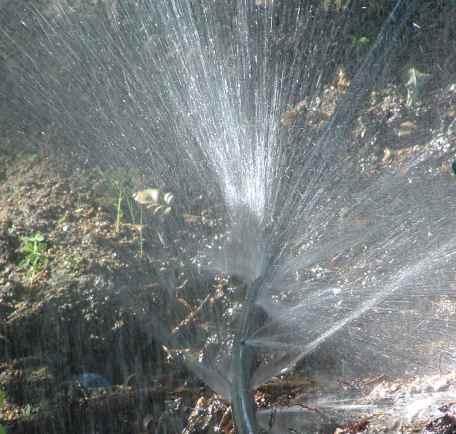A Simple Guide to Restoration
Restoring California Native Ecosystems.
Ok, really simple, 4000 plants/acre. Mix shrubs, trees and perennials that existed on the site or within a mile or two of the site on the same aspect and soil. Maintain for three years weed free. (Not one weed, dead or alive.)
Contract should read, weed free with 90% plant survival after one year, 80% second year, 70% third year. (All they have to be is alive, not pretty, but alive.) Monitoring should consist of confirming species for site, and for three times, once each year, count live plants, confirm no weeds.(Mowed=weeds, mulch is not a weed, dead weeds are.) If at the end of three years 70% survival not achieved, project starts again for areas that failed, contractor responsible for plants, watering, maintenance, owner (private or public) is responsible for monitoring three more years.
Let the contractor figure out watering, planting and weeding. (Contractor hint, plant 120-150% of needed plants and maintain once every two weeks for first year, about once a month after.)
Revegetation = covering the ground with vegetation(usually non-native). Looks like hell.
Restoration = A planting composed of 100% California native plants with components from the pioneer, sub-climax and climax communities. The ecosystem should represent the native appearance in the 1400's, have no alien, foreign, exotic components present (i.e. weeds, plastics, fertilizers, soil amendments, etc.) , and maintained for 1-3 years with no water.
Weeds+Bare soil are suppressed by Native litter(mulch) and mature native plants. At initial planting the site will look like a landscape, as it matures it should look and behave like a native ecosystem with weed suppression and self generation, if you get it right.
It is very important to understand what is supposed to be there. Just because the hillside is covered with one kind of native plant, doesn't mean that is what is supposed be there. Try to find an old guy (or gal) with no teeth that remembers where some old pictures are that show what was on the hillsides. In the following photo the hillside is covered with Chamise, looks like classic chaparral. Classic chaparral is a stage of chaparral that has burned too many times, too often. This hillside was covered with 20 foot high Big Berried Manzanitas, oak and pines in the 1970's, two fires, one in 1979 another in 1985 knocked out all the native plant species except the crown-sprouters. The is not one pine or manzanita on the hillside, not one. A walk around the hillside and neighboring hillsides reveals about 100 species that were there. Make the plant list what should be there, not what is there now.
If you want native plants in your garden or restoration, kill the weeds.
KILL THE WEEDS!
The site must be maintained until there is canopy closure of perennial native species with full canopy or appropriately mulched and about 70% closure. Exotics are an ecological switch and cannot be allowed.(Johnson and Wedin, 1997; Wilson, 1997) They are like a bacteria infection in a human body, your body can tolerate some infection, but even an ingrown toenail can become infected beyond your body's ability to suppress infection and without antibiotics (herbicides) you'll die. KILL THE WEEDS!
If there are presently live, perennial native plants covering more than 60% of the surface area (canopy closure), and climax species (e.g., oak trees ) are present, no planting is needed. Weeds should be controlled with herbicides and the landscape/restoration maintained weed-free until the landscape is stable, about 3-5 years. On rocky slopes, you may be hard pressed to find even 60% cover, if there are no weeds, that's normal and no inputs are needed.
If there are bare areas or weedy areas larger than 30 ft. (Brush), or 100 ft. (open woodland), plants should be planted to fill-in these holes, weeds should be controlled with herbicides, the area mulched, and maintained weed free until canopy closure. The exceptions are like the rock slope in the picture, seasonally flooded areas, and vernal pools, bare ground is fine in those sites, weeds are not. Large quantities of organic matter do not occur in hillside soils. Amended soil only occurs in some riparian systems and favors bacterial diseases, not natives(Coleman, et. al. 1988).
DO NOT AMEND SOIL.
Fertilizers do not occur in native ecosystems.
A change in fertility levels of a few parts per million will alter the ecosystem . Like a spinning top on a table, who knows where it will go?(Perry, et. al., 1989; Arnolds, Eef. 1991; Vitousek, Peter, et. Al. 1997)
DO NOT FERTILIZE.
Mycorrhizal inoculum is not needed nor appropriate for any site.(Williams and Aldon, 1976;Mitchell and Smith, 1992;Amaranthus,M.P., C.Y. Li and D.A. Perry. Trappe, James. 1988.). Inoculum is a newer version grassing hillsides, both permanently alter the ecosystem into at best an unstable one, at worst a weedy mess.
DO NOT USE Mycorrhizal inoculum. Sometimes if a hydroseeded site has been heavily worked and compacted, specific mycorrhiza can help, but if you're planting containers, use of mycorrhiza may be negative instead of positive.
Erosion: Low on a native site, very high on a grassy site, high on a bare site! (Patric, 1974)
Mulch drives a site to that mulch. Oak mulch plants Oak Trees; Pine needles plants Pine Trees; Straw creates a non-native Pasture; Redwood mulch favors Redwoods and most coastal California plants, Brush chips favors Conifers or Oaks; Rock Mulch plants desert plants; No mulch favors rivers, marshes, estuaries; Manure you get the idea.(Read, Francis, and Finlay, 1985; Putten, Van der, C. Van Dijk & B. A. M. Peters. 1993.)
DO USE THE RIGHT KIND OF MULCH!
Do not be cheap! Garbage on garden, garbage in garden.
(Mulch table is adapted from the Vandenberg Landscape
Ordinance.(Wilson, Bert, 1996))
The
plastic tubes that are billed as 'tree
saviors' (or whatever) kill our plants in interior locations. In
others
they alter the plants ecology to where plants, that are never
browsed, are browsed, and, like when drip
is used, the plant's life is dramatically shortened.
After five years the numbers seem to be unsupported. Moreover,
Carey and Robertson(1995) found that
Bluebirds and other birds die in the shelters attracting rodents
that tunnel under, or eat through the plastic and eat the plant.
Take your money and spend it on mulch, maintenance, one to five
really good waterings, and more plants.
| Mulch Type | Best used for | Not recommended for |
Possible Problems with
|
Sources of | Life of Mulch |
| Lawn clippings, Straw, or Hay | compost pile for vegetable garden | any plantings other than vegetable, it kills natives | many weeds (e.g.,,bind weed, mustard, bermuda grass), plant diseases | many | 3 months |
| Manure | Vegetable garden | Any other plantings, it kills natives | Salt burn | Any Garden center | 1-3 months |
| 'Green waste' | Conventional flower beds | interface areas, native plantings, conifers ,desert plants | weed seeds, shrub and tree seeds | Recycling programs | 1-3 years |
| Arborist's chippings of pine, oak or natives | native or drought tolerant type plantings and conifers | conventional flowerbeds, vegetable gardens, desert plants | few but some tree and shrub seeds |
Arborists
|
5-7 years |
| Fir bark, Pine bark, Redwood bark | conifers, most native prefer redwood, most others Ok |
conventional flowerbeds, vegetable gardens, desert plants
|
floats and moves off of site, doesn't provide full groundcover so more weeds present | Bulk distributors, Garden centers | 7-10 years |
| Shredded redwood bark (Shredded cedar is similar) |
the best mulch (when combined with boulders) for coastal and sierra natives | desert plants, conventional gardens | no known negative impacts | Bulk distributors | 7-10 years |
| Boulders, rock | Desert plants or combined with other mulch | areas next to lawn or parking lots (Ok if too large to easily move) | vandalism | bulk distributors, some General Engineering contractors | 20+ |
|
None
|
Lawns, walkways, parking lots, river bottoms, marshes | most native or drought tolerant sites | topsoil loss, erosion | N/A | generally covered with weeds in a few months |
| Plastic | Lawn furniture | plants | shreds, doesn't work, kills the plants | 'home' stores, 'restoration' suppliers | 1-3 years, replaced by weeds |
Ok we've given you these basics now make a table with the square footage of the target as the minimum total. Feed in every native perennial/shrub/tree that is present on the site or on nearby sites that represent your site. Do not feed into the table Baccharis, Senecio, Ericameria, Lotus or whatever other pioneer is on the site until your numbers are above 60% area coverage (accounting for possible losses). The table should represent your 'dream' species list of a permanent planting. The more species you can include the better. After you've figured out your plant list, add a full overlay of bush Baccharis or whatever start up plant is native in the area. Most of the coastal areas of California prefer Baccharis.
Here's an example for a little creek bank. The native cover target is about 60-70%, with the Baccharis added we project 130% coverage with a 30% loss, that is canopy closure. Actual area was about 600 sq. ft.
| Quantity | Genus/species | Common Name | Projected width (in ft.) of one plant after3 years | Projected area (in sq. ft.) covered by one plant | Total area (in sq. ft)covered by the listed quantity of plants | Total coverage with 30% loss (sq. ft.) |
| 22 | Artemisia douglasiana | Mugwort | 3 | 9 |
198 |
139 |
| 10 |
Artemisia californica | California Sage Brush | 3 |
9 |
90 |
63 |
| 15 |
Baccharis pilularis consanguinea | Coyote Brush | 6 |
36 |
540 |
378 |
| 10 |
Carex spissa | 2 |
4 |
40 |
28 |
|
| 5 |
Juncus textilis | Basket Rush | 2 |
4 |
20 |
14 |
| 3 |
Psoralea (Hoita)macrostachya | Leather Root | 3 |
9 |
27 |
19 |
| 10 |
Rhamnus californica | Coffeeberry | 3 |
9 |
90 |
63 |
| 15 |
Symphoricarpos albus | Snowberry | 3 |
9 |
135 |
94.5 |
| 80 |
Totals |
1140 |
798 |
|||
Amaranthus, M.P., C.Y. Li and D.A. Perry. 1990. Influence of vegetation type and Madrone soil inoculum on associative nitrogenfixation in Douglas-fir rhizospheres. Can. J. For. Res. 20:368-371
Arnolds, Eef. 1991. Decline of ectomycorrhiza fungi in Europe. Agriculture, Ecosystems and Environment, 35, 209-244
Carey, R. A., and D. J. Robertson. 1995. Tree shelters lead to unexpected problems (Pennsylvania). Restoration and Management Notes 13(1):134.
Coleman, David, D.A. Crossley, M.H. Beare, and P.F. Hendrix. 1988. Interactions of Organisms at Root/Soil and Litter/Soil Interfaces inTerrestrial Ecosystems. Agri.,Ecosystems and Environment, 24:117-134
Johnson, Nancy, and David Wedin. 1997. Soil Carbon, Nutrients, and Mycorrhizae during Conversion of Dry Tropical Forest toGrassland. Ecological Applications, 7;10, 1997 pp.171-182
Mitchell, R.J. and D.B. South. 1992. Cultural enhancement of mycorrihizal fungi on southern pines? Pp. 145-153. In nPoc. 1992 JointInternational Symposium on Air Pollution, Soil Microbiology and Biotechnology of Forestry. National Taiwan University. Taipei,Taiwan.
Patric, James. 1974. Water Relations of some Lysimeter-Grown Wildland Plants in S. Calif.. Pacific S.W. Forest & Range Expt. Station,U.S. Forest Service, 110 N. Wabash Ave. Glendora, Ca. 91740.
Perry, D.A., M.P. Amaranthus , J.G. Borchers and R.E. Brainerd. 1989.Bootstrapping in Ecosystems. BioScience Vol. 39(4) pp. 230-237
Putten, W.H. Van der , C. Van Dijk & B. A. M. Peters. 1993. Plant-Specific soil-Borne Diseases contribute to succession in foredunevegetation. Nature Vol. 362. 4 pp. 53-55
Read, D.J., R. Francis and R.D. Finlay. 1985. Mycorrhizal mycelia and nutrient cycling in plant communities., Ecol. interactions in soil.ed. by Fitter et.al.. Blackwell Sci. Pub.pp
Trappe, James. 1988, Lessons from Alpine Fungi. Mycologia,80(1). Presidential address, Mycological Soc. of America, Ottawa, Ontario,Ca. June 24, 1987 Of the 'Silver Bullet' of Bioengineered Mycorrhiza "Such nonsense can be perpetrated only by the ecologicallyignorant, the non-symbiotic Lone Rangers who, as the non-mycorrhizal annual weed, move in fast to get the most. Unfortunately, it maybe believed by unsophisticated readers, of which there are many. "
Vitousek, Peter, John Aber, Robert Howarth, Gene Likens, Pamela Matson, David Schindler, William Schlesinger, and David Tilman.1997. Human Alteration of Global Nitrogen Cycle: Sources and Consequences. 7(3), pp.737-750
Williams, Stephen and Earl Aldon. 1976. Endomycorrhizal(Vesicular Arbuscular) Assoc. of some Arid Zone Shrubs. The SouthwestNaturalist. 20(4):437-444.
Wilson, Bert. 1996. Landscape Ordinance for Vandenberg Air Force Base. Task Assignment F04684-95-C-0045
Wilson, Bert and Celeste. 1997.Vegetation Mitigation Annual Report, California Spaceport. Vandenberg Air Force Base, California
Please feel free to copy and distribute!
Bert Wilson
September 1997, updated 2001
REMEMBER, the only place you'll find a hole with "amendments" in it, lots of water, and plastic around it is in the camp latrine!
"Only two things are infinite, the universe and human stupidity, and I'm not sure about the former." Albert Einstein
